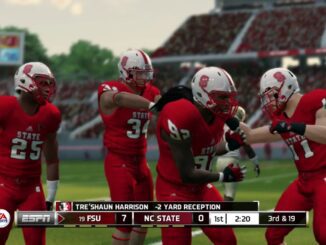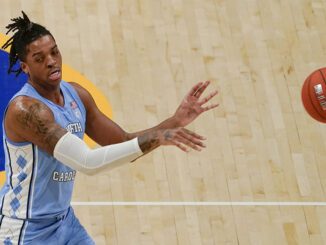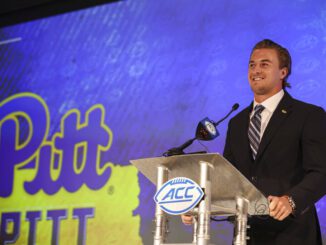
NEW YORK — In a Michigan basement decked out in maize and blue, a father sat with his son.
They’d bond over a football video game. One with a story mode that would transport the 7-year-old into a college dorm room where letters from fans filled his mailbox, the campus newspaper teased a championship and a list of Heisman candidates adorned his computer screen. If he played well enough, his name might even appear there.
It wasn’t real. But who was to say it couldn’t be?
“You know, we’d always joke because he was a big kid that, ‘Hey, maybe you’re going to be on there someday,’” says the father, Bill Swartout.
Today, more than a decade later, that 7-year-old — Brayden Swartout — is an offensive lineman at Central Michigan, living the story mode in real life.
Countless versions of that game, not made in over a decade, collect dust in basements alongside phased-out gaming systems. It’s the inevitable fate of old discs, gaming cartridges, RCA connector wires and the like. Give it all a good blow, though, and the dust clears to reveal an enduring cultural phenomenon that, in this modern world, is on its way back.
For a generation of youth, EA Sports’ college football games fueled their aspirations in the sport. From the early versions in the 1990s to the immersive experiences in the 2000s that revolutionized create-a-player modes, the games became a must-have for sports and video-game fans.
As they grew more popular, however, something else grew, too: the chorus of voices that said college athletes depicted in the game should be getting paid. It was a notion that seemed preposterous in the student-athlete era. But as opinions morphed, it started to make sense.
Before 2021, college athletes were not allowed by the NCAA to profit from their brand, commonly known as their name, image and likeness — or NIL.
The video-game developer tried for years to differentiate in-game rosters from real-life players. “Quarterback No. 10” remembers this clearly.
“I remember when I was in the game. Obviously in high school and all that you want to be in the game, but then when you get to college you’re in the game, and I’m No. 10 from Baylor, before NIL, and I am No. 10,” Robert Griffin III, one of the game’s 2013 cover athletes and the 2011 Heisman winner, told The Associated Press.
“And that’s my name, ‘Quarterback No. 10 from Baylor,'” he says. “But, I’m like, white with a buzz cut fade and no arm sleeve on my arm and I’m from Tuscaloosa, Alabama. They completely tried to change the character just so they don’t have to pay the guy. Or say, ‘Oh no, that’s not his name, image and likeness, he’s not even the right color.’ But everybody knew who No. 10 from Baylor was.”
Eventually, EA Sports gave up. And so the franchise sat after its last version in 2013, dormant for 11 years.
Society has changed a lot since the 2010s. So has Swartout’s basement, now decked out in Central Michigan’s maroon and gold.
Gamers’ voracious appetites for immersive sports video games have not changed as much. And with the NCAA’s decision to allow college athletes to profit from their brand, the time had come.
EA Sports in 2021 announced it would be reviving the franchise. Three years later, the game is scheduled to be released this summer with a full reveal promised this month. Details have been few so far, but players’ names and likeness will be real.
“I personally believe that NCAA Football is the greatest game ever made,” Griffin says. “A lot of kids growing up with the game wanted to be able to see themselves grow and develop into those players they were creating.”
EA Sports has offered Football Bowl Subdivision players a minimum of $600 and a copy of EA Sports College Football 25 to be featured in the game. More than 10,000 players have accepted.
The new iteration of EA Sports College Football will retain a key difference from the other sports games on the market as it will be the only college football game.



